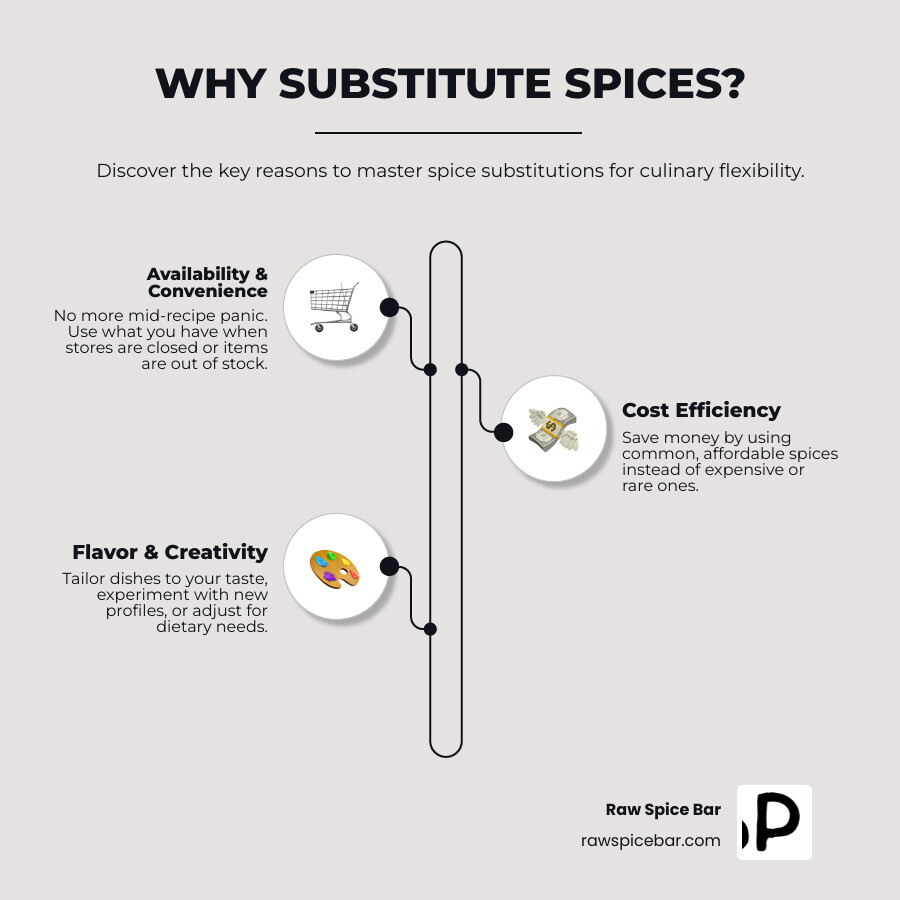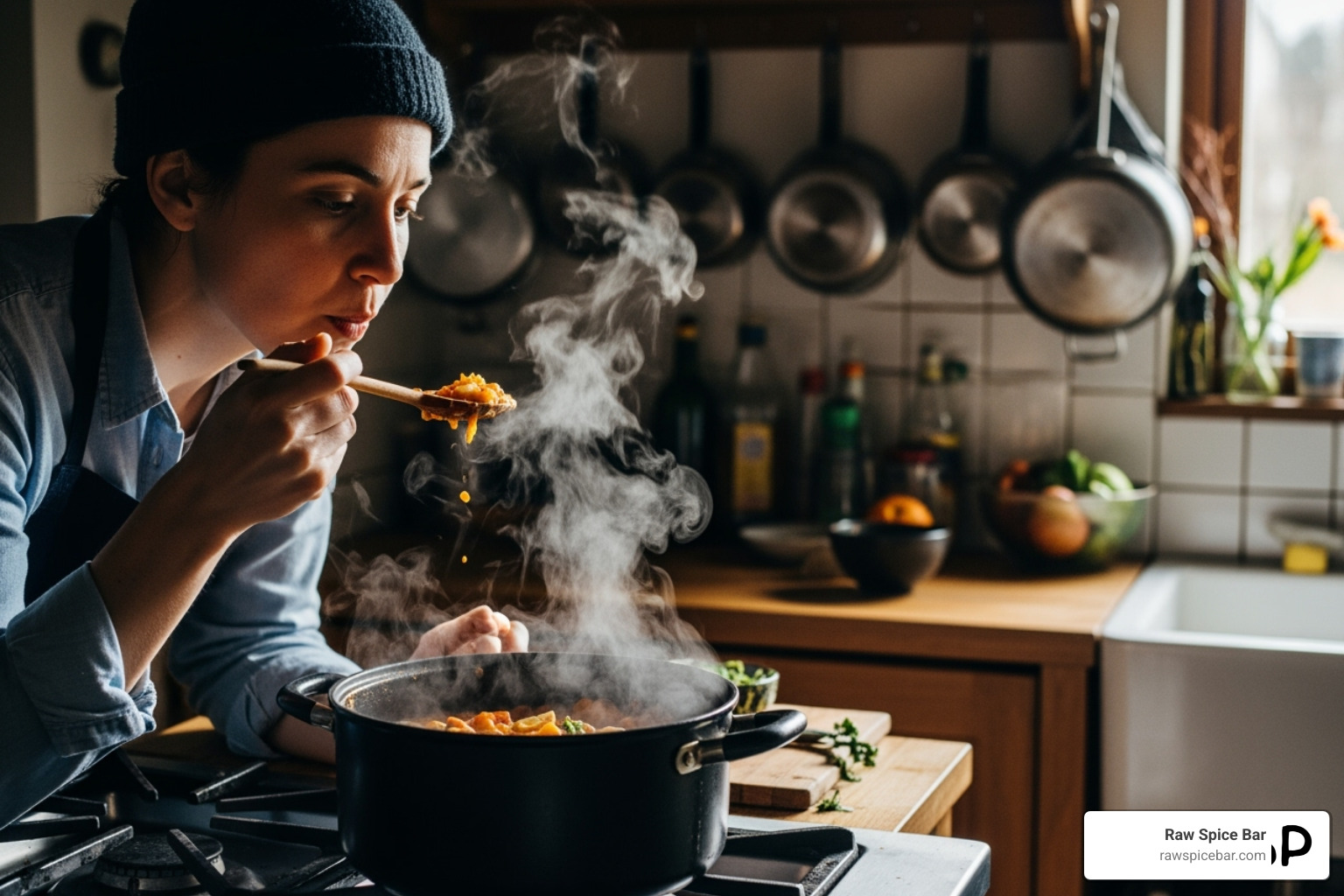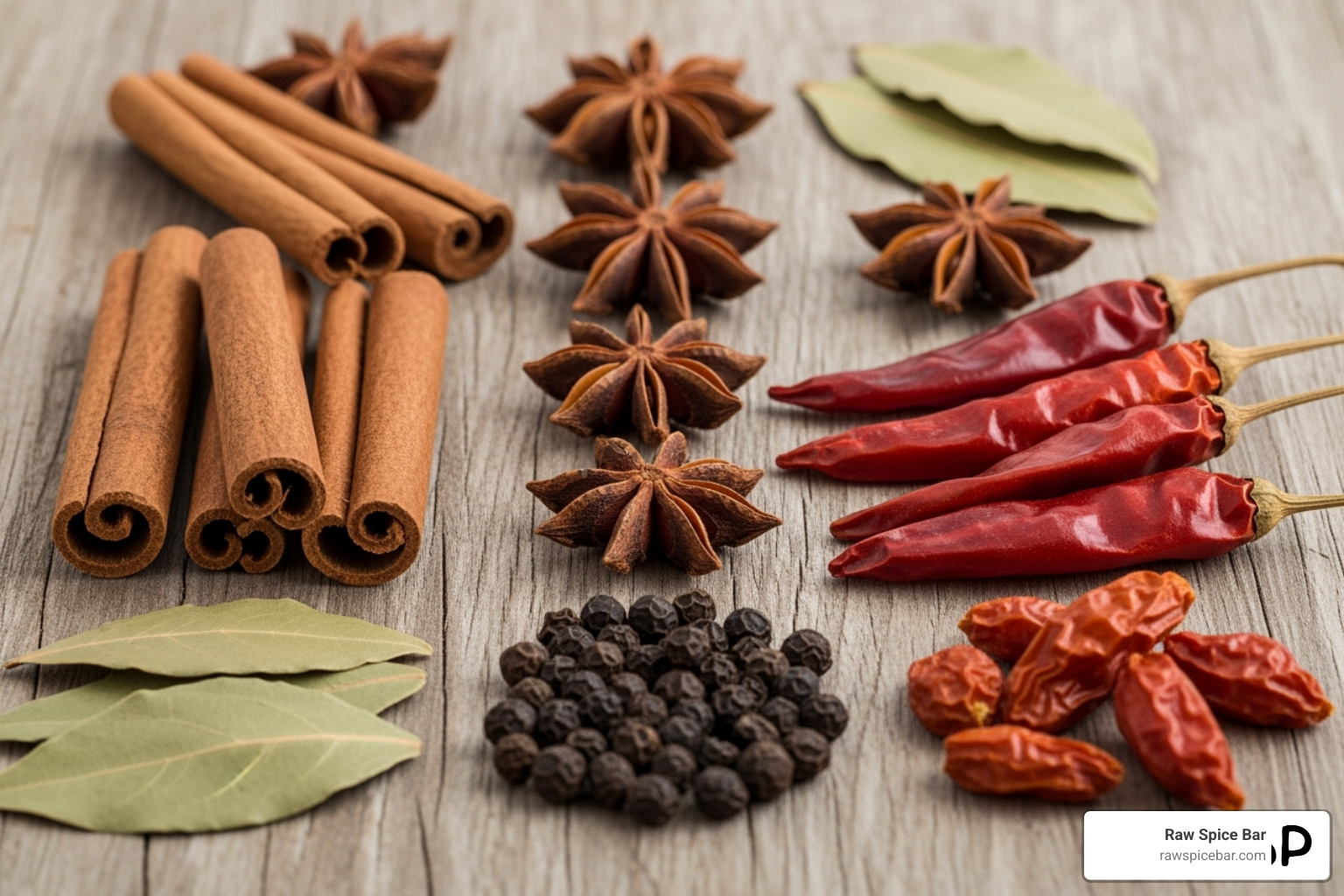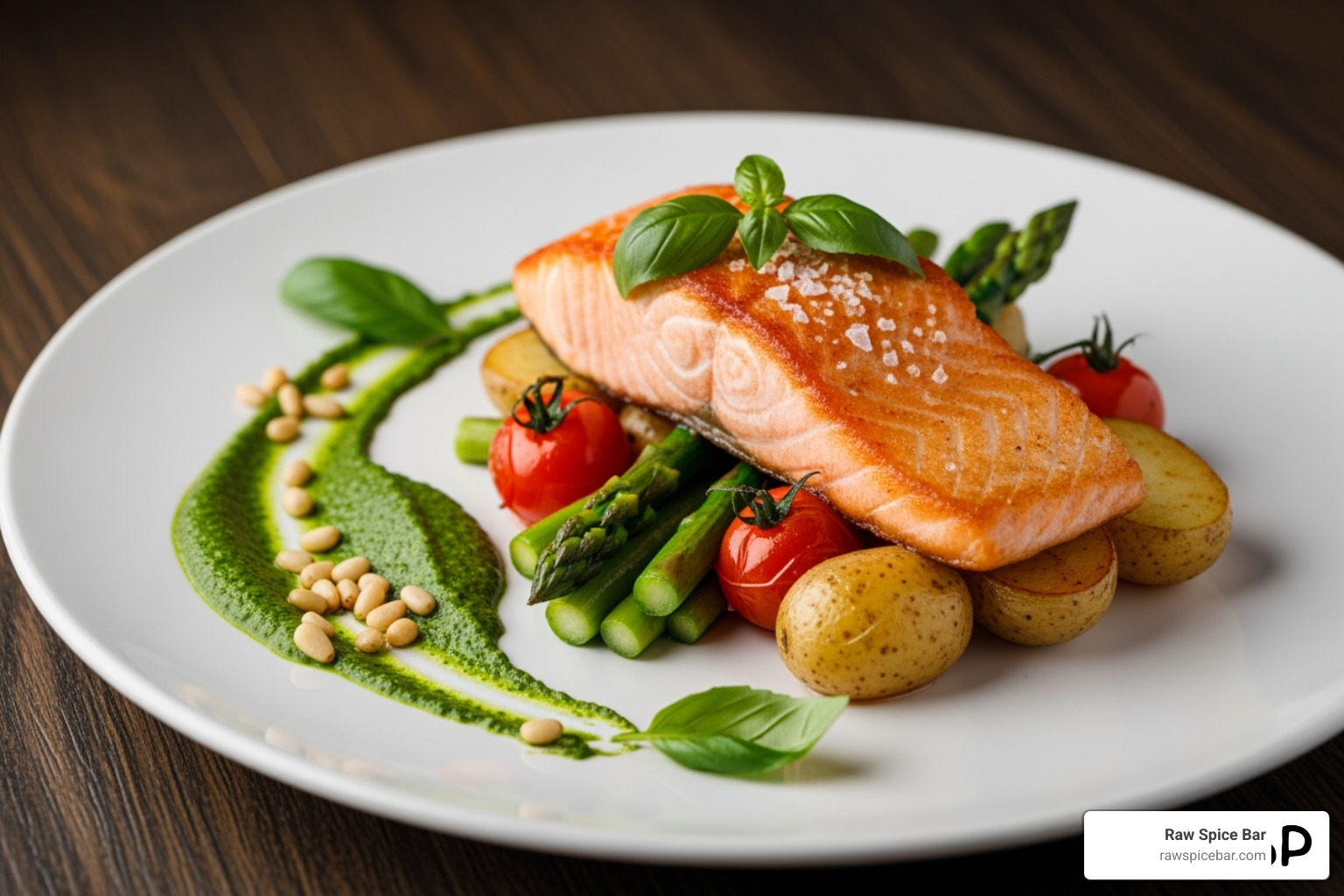Never Get Stuck Mid-Recipe Again
Best spice substitutes can save your dinner when you're halfway through cooking and realize your spice cabinet is missing that crucial ingredient. Here are the most effective substitutions you can make with common pantry staples:
Quick Reference Guide:
- Cumin → Ground coriander (use half the amount)
- Paprika → Chili powder or cayenne (start with 1/4 amount)
- Oregano → Basil, thyme, or marjoram
- Allspice → Equal parts cinnamon, nutmeg, and cloves
- Garlic powder → Fresh garlic (1 clove = 1/8 tsp powder)
- Bay leaves → Thyme or oregano
- Cardamom → Cinnamon plus nutmeg
- Sage → Rosemary or thyme (use less)
As one home cook perfectly captured the frustration: "There's nothing worse than being in the middle of a recipe and realizing you've run out of something."
The good news? Most spice substitutions work beautifully when you understand the basic principles. Some substitutes might even save you money - many cooks skip buying expensive spices like saffron or cardamom and use cheaper alternatives that deliver similar results.
Why you need spice substitutes:
- Your local store is out of stock
- The spice costs too much
- You want to experiment with new flavors
- You're cooking late and stores are closed
I'm Joseph Rosenblatt, founder of a successful spice company, and I've spent years perfecting best spice substitutes for home cooks who want great flavors without the hassle. My experience creating premium spice blends taught me that smart substitutions often work better than the original ingredient.

Common best spice substitutes vocab:
The Golden Rules of Spice Swapping
Picture this: you're halfway through making your grandmother's famous curry when you realize the cumin jar is completely empty. Before you throw in the towel or make a frantic grocery run, take a deep breath. Understanding best spice substitutes is like having a culinary safety net that transforms potential kitchen disasters into creative cooking trips.
Knowing spice substitutions isn't just about emergency cooking – it's about kitchen preparedness, culinary creativity, and yes, even saving money. Why spend $8 on a jar of mace when you can create a similar flavor profile with nutmeg and cinnamon? Smart home cooks skip expensive single-use spices and master the art of substitution instead.
The magic of successful spice swapping lies in understanding what each ingredient brings to your dish. Every spice serves a purpose, whether it's adding flavor, creating color, or contributing to texture. When you substitute, you're essentially playing matchmaker between flavors.
Here's the golden rule that professional chefs swear by: start with half the amount the recipe calls for and taste as you go. This approach saves you from overpowering your dish, especially when working with potent spices where a little goes a very long way.
Substitutions will change your final dish in some way. Swap out vibrant red paprika for cumin, and your dish loses that beautiful color. Use cayenne instead of mild chili powder, and suddenly your family dinner becomes a fire-breathing contest. These changes aren't bad – they're just different, and understanding them helps you cook with confidence.
The key is embracing these variations as part of your cooking journey. Sometimes a substitution creates an even better flavor than the original recipe intended.
Ingredient Substitutions Guide

Fresh vs. Dried Herbs: Mastering the Ratios
The fresh versus dried herb dilemma trips up even experienced cooks. The secret lies in understanding that dried herbs pack about three times more concentrated flavor than their fresh counterparts because all the water has been removed.
This means when a recipe calls for 1 tablespoon of fresh basil and you only have dried, use just 1 teaspoon of dried basil instead. The same 3:1 ratio works beautifully for oregano, rosemary, thyme, parsley, tarragon, chives, and mint.
| Fresh Herb (1 Tbsp) | Dried Herb (Approx. Equivalent) |
|---|---|
| Basil | 1 tsp |
| Oregano | 1 tsp |
| Rosemary | 1 tsp |
| Thyme | 1 tsp |
| Parsley | 1 tsp |
| Tarragon | 1 tsp |
| Chives | 1 tsp |
| Mint | 1 tsp |
Timing matters just as much as quantity when working with best spice substitutes. Dried herbs need time to bloom and release their flavors, so add them early in the cooking process. Fresh herbs are the opposite – they're delicate and should be added near the end to preserve their bright, vibrant taste.
For cold dishes like salads or dips, add your herbs several hours before serving. This gives the flavors time to marry and develop into something truly delicious.
Ground vs. Whole Spices: A Quick Conversion Guide
Here's a game-changing tip: whole spices stay fresh and flavorful much longer than pre-ground versions. When you grind spices fresh, the difference in aroma and taste is absolutely remarkable – it's like comparing a fresh-picked tomato to one that's been sitting on the shelf for weeks.
If you have whole allspice berries and need ground allspice, six whole berries equal about 1/4 to 1/2 teaspoon ground. This same principle applies to most whole spices.
When a recipe calls for ground cumin and you only have whole cumin seeds, don't panic. Simply toast the seeds in a dry pan for 30 seconds until fragrant, then grind them in a spice grinder or mortar and pestle. The warm, earthy flavor you'll get is far superior to pre-ground cumin that's been sitting in your pantry for months.
Freshly ground spices are more potent than their pre-ground counterparts, so start with slightly less than the recipe calls for and adjust to taste.
More info about Cumin substitutes.
Your A-Z Guide to the Best Spice Substitutes

Finding the right spice substitute doesn't have to feel like solving a puzzle. Once you understand how flavors work together, swapping spices becomes as natural as seasoning to taste. Let's break down the best spice substitutes by flavor families, so you'll know exactly what to reach for when your spice rack comes up short.
Warm & Sweet: Finding the best spice substitutes for baking
These cozy spices make our kitchens smell like home and turn simple ingredients into something magical. When you're baking and find you're missing a key spice, don't panic – these swaps will save your dessert.
Allspice gets its name because it tastes like a warm hug from cinnamon, cloves, and nutmeg all at once. No allspice? Mix equal parts cinnamon, nutmeg, and cloves. This homemade blend often tastes fresher than store-bought anyway! Best Allspice Substitute
Cinnamon is the superstar of sweet spices, but nutmeg or allspice can step in when needed. Use about one-quarter the amount since they pack more punch than cinnamon's gentle warmth.
Nutmeg brings that mysterious, almost floral note to holiday treats. Its closest relative, mace, works perfectly as a substitute. You can also blend cinnamon and cloves for a similar warm complexity. Alternatives to Nutmeg
Cloves deliver intense, almost medicinal warmth that's essential in gingerbread and mulled wine. Allspice is your best bet here, or try mixing cinnamon and nutmeg for a gentler approach.
Cardamom is the exotic beauty of the spice world with its floral, citrusy complexity. Ground ginger works surprisingly well, or combine cinnamon and nutmeg to mimic those warm undertones. Best Cardamom Substitute
Ginger adds that bright, spicy zing to everything from cookies to curries. When you're out, allspice, cinnamon, nutmeg, or mace can each bring their own version of warmth to your dish.
Earthy & Savory: The best spice substitutes for hearty dishes
These are the workhorses of your spice cabinet – the ones that build deep, satisfying flavors in stews, roasts, and everyday cooking. They're the backbone of cuisines from Mexico to Morocco.
Cumin brings that nutty, lemony earthiness that makes tacos and curries sing. Ground coriander is your best friend here, though use half the amount since it's milder. Caraway seeds work too, but start small – they're quite strong. If you have chili powder, taco seasoning, or curry powder on hand, they often contain cumin and can work in a pinch. What to Use Instead of Cumin
Coriander offers those bright, lemony notes that balance heavier flavors. Cumin or caraway seeds make excellent best spice substitutes, bringing similar earthiness with their own unique twist. Best Coriander Substitute
Paprika ranges from sweet and mild to smoky and fiery, depending on the variety. Mild chili powder works well, or use just a tiny pinch of cayenne for both color and heat. Red pepper flakes can add similar visual appeal with a bit of warmth. Best Paprika Substitute
Turmeric is tough to replace because of its unique earthy flavor and golden color. Ground mustard can provide similar pungency, while a pinch of saffron (if you're lucky enough to have it) offers that gorgeous yellow hue.
Garlic powder is incredibly convenient for dry rubs and seasoning blends. Fresh garlic works beautifully – one clove equals about 1/8 teaspoon powder. If you only have garlic salt, remember to reduce other salt in your recipe by about 3/8 teaspoon for every 1/2 teaspoon of garlic salt used. Onion powder provides similar savory depth, though with its own distinct character. Best Garlic Powder Substitute
Pungent & Spicy: Turning Up the Heat
When you want to add fire to your food, these spices deliver. Each brings its own personality to the party – some sharp, some smoky, some downright blazing.
Cayenne pepper sits at a respectable 30,000 to 50,000 Scoville units, providing clean heat with vibrant color. Sweet paprika gives you the color without much heat, while hot paprika gets you closer to cayenne's intensity. Red pepper flakes offer similar heat with different texture, and chipotle powder brings smoky complexity. Even black pepper works when you want a different kind of warmth. Best Cayenne Pepper Substitute
Chili powder is actually a blend containing ground chiles, paprika, cumin, garlic, and oregano. Make your own by combining these ingredients, adjusting the cayenne to control the heat level. Chili Powder Substitute Showdown
Chipotle powder comes from smoked jalapeños, so it brings both heat and that distinctive smoky flavor. Smoked paprika is your best spice substitutes option here, delivering similar smokiness with milder heat. Regular chili powder works if you don't need the smoke. Best Chipotle Powder Substitute
Black pepper is the king of everyday spices, adding sharp pungency to almost everything. White pepper works as a direct substitute, especially in light-colored dishes. For different flavors, try paprika for color and mild heat, or ground mustard for gentle pungency.
Herbaceous & Aromatic: Fresh Flavors
These herbs bring brightness and complexity to our cooking, each with its own personality. They're what make the difference between good food and memorable food.
Rosemary has that distinctive piney, almost resinous flavor that transforms roasted meats and vegetables. Thyme, savory, or marjoram can step in, though use them sparingly since rosemary is quite bold.
Sage brings earthy, almost fuzzy warmth to dishes, especially with poultry. Poultry seasoning often contains sage and works well, or try savory, thyme, or marjoram in smaller amounts. Guide to Sage Leaf Substitutes
Thyme is one of cooking's most versatile herbs, offering warm, woody notes. Basil, oregano, or marjoram make excellent best spice substitutes, each bringing their own character to your dish.
Oregano delivers those bright, minty-lemon notes that define Mediterranean cooking. Basil, thyme, Italian seasoning, or marjoram can fill in beautifully.
Marjoram is oregano's gentler cousin, with delicate citrusy and piney notes. Oregano works well (use less since it's stronger), along with thyme or sage. Versatile Marjoram Substitutes
Bay leaves add that subtle, aromatic background note that's hard to pinpoint but impossible to miss. While nothing truly replaces bay leaves, a pinch of dried thyme or oregano can provide similar aromatic complexity to your slow-cooked dishes. Best Bay Leaf Substitute
DIY Spice Blends: Cheaper & Better Than Store-Bought

Here's something that might surprise you: making your own spice blends is one of the smartest ways to master best spice substitutes. Instead of panicking when you're out of Italian seasoning or pumpkin pie spice, you can whip up fresh blends in minutes using individual spices you likely already have.
The customization benefits are incredible. Want less salt in your taco seasoning? You control that. Prefer more heat in your curry powder? Add extra cayenne. Store-bought blends often contain fillers, excess sodium, or sugar we don't need. When we make our own, we know exactly what's going into our food.
Controlling salt and sugar becomes effortless when you mix your own blends. Many commercial spice mixes are loaded with sodium as a preservative and flavor improver. By creating our own versions, we can dramatically reduce salt content while boosting actual spice flavors.
The freshness factor makes a huge difference in taste. Those individual spices sitting in your cabinet are likely much fresher than pre-mixed blends that have been sitting on store shelves for months. When you combine fresh spices right before using them, the aroma and flavor intensity are noticeably better.
How to Make Italian Seasoning
Italian seasoning might be the easiest blend to master, and it's perfect for pasta sauces, roasted vegetables, and grilled meats. The beauty lies in its simplicity - you're combining dried oregano (2 tablespoons), dried basil (2 tablespoons), dried thyme (1 tablespoon), dried rosemary (1 tablespoon, crushed), and garlic powder (1 teaspoon) for a classic blend.
The simple ratios make this foolproof. Start with equal parts oregano and basil as your base, then add half that amount of thyme and rosemary. A touch of garlic powder rounds everything out perfectly. Mix thoroughly and store in an airtight container for up to six months.
This homemade version tastes fresher and more vibrant than anything you'll find in stores. Plus, you can adjust the ratios based on your preferences - love garlic? Add more garlic powder. Prefer a pine-forward flavor? Increase the rosemary slightly.
How to Make Pumpkin Pie Spice
Nothing says fall like pumpkin pie spice, but buying a separate jar seems wasteful when you can create it from spices you probably have. The magic happens when you combine ground cinnamon (3 tablespoons), ground ginger (4 teaspoons), ground nutmeg (3 teaspoons), ground allspice (1 teaspoon), and ground cloves (1 teaspoon).
Cinnamon forms the base of this warm, aromatic blend, while ginger adds that subtle heat we associate with autumn baking. Nutmeg brings sweetness and depth, while allspice and cloves provide the complex, warming notes that make pumpkin pie spice so distinctive.
This recipe makes about 6 tablespoons - enough for several batches of cookies, a couple of pies, or plenty of spiced lattes. The fresh blend smells incredible and tastes far more vibrant than store-bought versions.
Best Pumpkin Pie Spice Substitute
How to Make a Simple Curry Powder
Creating your own curry powder opens up a world of flavor possibilities. While curry blends vary dramatically by region, a simple version starts with turmeric (4 tablespoons) as the base, providing that characteristic golden color and earthy flavor.
Coriander (2 tablespoons) and cumin (2 tablespoons) form the aromatic heart of the blend, while ginger (1 tablespoon) adds warmth. Black pepper (1 teaspoon) provides heat and helps activate turmeric's beneficial compounds. Fenugreek (1/2 teaspoon) adds that distinctive curry aroma, though it's optional if you don't have it.
The beauty of homemade curry powder is adjusting heat to your preference. Start with 1/4 teaspoon cayenne pepper and increase from there. This blend works beautifully in chicken curries, roasted vegetables, or even as a seasoning for roasted potatoes.
Frequently Asked Questions about Spice Substitutions
What spice is hardest to substitute?
Saffron takes the crown as the most challenging spice to substitute effectively. This precious ingredient brings a uniquely complex flavor profile - subtly floral, slightly sweet, and earthy - while painting dishes like paella and risotto with its signature golden-yellow glow.
The problem isn't just saffron's distinctive taste. It's also the world's most expensive spice by weight, thanks to its incredibly labor-intensive harvesting process. Picture this: farmers need an entire acre and 75,000 crocus flowers to produce just one pound of saffron threads. No wonder it costs more than gold!
While we can't truly replicate saffron's flavor, we can mimic its color factor. Turmeric works as a 1:1 substitute for that golden hue, though it brings its own earthy flavor to the party. Paprika can also provide some color, but again, the taste will be completely different.
Honestly, when a recipe truly depends on saffron's magic, we have two choices: splurge on a tiny amount of the real deal or choose a different dish entirely. Sometimes there's just no substitute for the original.
Can I use a spice blend instead of a single spice?
Absolutely! Using spice blends as best spice substitutes for individual spices can be a brilliant kitchen hack - just approach it with some awareness and caution.
Many commercial blends contain the exact spices you're looking for. Take chili powder, for example. It typically includes cumin, paprika, garlic powder, and oregano. If your recipe calls for cumin and chili powder is all you have, go for it! Just remember you're introducing extra flavors and possibly some heat.
The secret is checking blend ingredients first. Look at what's actually in that seasoning mix and think about how those additional flavors will play with your dish. Will that extra oregano complement your recipe or clash with it?
Missing Chili Powder? Here's What to Use
Watch out for salt content too. Blends like taco seasoning can be surprisingly salty. When we use these salty blends, we adjust other seasonings in the recipe to avoid turning our dinner into a sodium bomb.
Our golden rule? Start with less than you think you need and taste as you go. Your palate is the best judge of whether that substitution is working.
Do spice substitutes affect the health benefits of a dish?
This is such a thoughtful question! While we usually focus on flavor vs. function when making substitutions, the truth is that different spices bring different health benefits to the table.
Take sumac, that wonderfully tangy Middle Eastern spice. Beyond its bright citrusy flavor, sumac packs impressive antioxidant properties and may even help with blood sugar balance. If we swap it for lemon zest, we'll get similar tartness but miss out on those specific health perks.
The same goes for herbs like basil, which offers antibacterial and anti-inflammatory benefits. While oregano might nail the flavor substitution, it won't deliver identical medicinal qualities.
Here's the good news: using fresh ingredients and making your own spice blends puts you in the driver's seat. You control what goes into your food, including sodium levels. When we create our own blends, we can skip the excess salt that many commercial mixes contain - a win for both flavor and health.
The bottom line? Substitutes primarily solve flavor and availability challenges. But being aware of what unique benefits you might be trading away helps you make more informed choices in the kitchen. It's all part of becoming a more confident, well-rounded cook.
Conclusion: Accept Your Inner Spice Alchemist
Mastering best spice substitutes is like open uping a secret superpower in your kitchen. You'll never again have to abandon a recipe halfway through or make that frantic late-night grocery run just for one missing spice.
The key principles we've covered - starting with smaller amounts, tasting as you go, and understanding how substitutions affect flavor, color, and texture - will serve you well in countless cooking trips. Whether you're swapping cinnamon for nutmeg in your morning coffee cake or using coriander instead of cumin in your favorite curry, these skills build genuine culinary confidence.
What excites me most is watching home cooks transform from recipe-followers into creative experimenters. That's the real magic of understanding spice substitutions. You stop being intimidated by exotic ingredient lists and start seeing possibilities everywhere you look.
At Raw Spice Bar, we believe every home cook deserves to explore global flavors without barriers. We love introducing you to authentic spices from around the world through our monthly subscription. But we also want you to feel empowered to cook boldly with whatever you have on hand.
Your spice cabinet is full of untapped potential. That lonely jar of cardamom can become your new favorite cinnamon substitute. Those whole peppercorns you never use? They're fresher and more flavorful than any pre-ground pepper you've tried.
Don't be afraid to experiment. The worst that happens is you learn something new about flavor combinations. The best that happens? You find a substitution that works even better than the original ingredient.
Find new flavors with our Spices 101 guides





